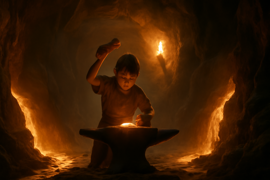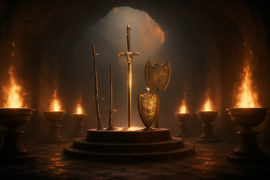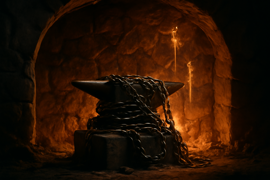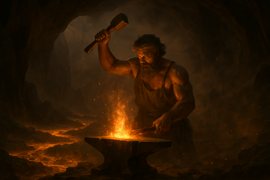Introduction
Beneath the smoldering peaks of Mount Etna, where rivers of molten lava weave like rivers of liquid gold through jagged basalt walls, there lies the hidden heart of the divine forge. Here, in a cavern scorched by the breath of the earth’s core, Hephaestus, the exiled son of Zeus and Hera, discovered both his purpose and his power. Legendary among gods and mortals for his unmatched skill at the anvil, Hephaestus shaped metal as though it were living flesh—each hammer strike echoing like distant thunder against the cavern’s vault. Though cast from Olympus for reasons that would haunt him in dreams of thunderbolts and frozen heights, he rose from the ashes of his fall with unwavering resolve. Every glowing ember under his hammer shone with the promise of redemption. The air trembled with the hiss of steam as Hephaestus drew inspiration from the roaring flares of the furnace. At his command, the raw ore—plucked from volcanic vents and blessed by fire itself—yielded to his will, transforming into divine weapons, elaborate chainmail, and even the first living automaton. It was in these crucibles of heat and hardship that his artistry fused with resilience, forging not just tools or armaments, but the very essence of his spirit. As the anvil rang out an unending cadence, whispers of his work traveled beyond the volcanic halls to free people and immortal patrons alike. Kings from distant shores, heroes born of mortal coil, and even the high lords of Olympus felt the echo of his triumph. Yet for all his fame, Hephaestus remained tethered to the magma-choked depths, committed to his craft and determined to prove that adversity, like cold metal, could be reforged into a legacy of brilliance.
Forged in Fire: The Smith’s Birth
Hephaestus’s earliest memories are carved in flame and stone. As a child of Olympus, he once walked in halls of marble and light, his laughter echoing beneath vaulted columns. But the storm of a family divided—Hera’s wrath at his birth, Zeus’s reluctant rescue—sent him plummeting into the dark, molten caverns of Lemnos. There, with only the rumble of the earth and the ceaseless hiss of boiling lava to keep him company, the fire god awoke to his destiny. At first, his arms trembled at the weight of a makeshift hammer he crafted from ocean-washed rock. Yet, each blow he struck against a primitive anvil of basalt chipped away at his doubts, forging confidence in its place. By nightfall, sparks danced around him like living fire-demons, illuminating the sweaty determination in his eyes.

It was in that subterranean crucible that Hephaestus first tasted the purity of creation. He learned to coax the metals from volcanic crevices: copper that shone like sunset, iron as red as blood, and bronze with a whisper of the sea’s memory. Each new alloy was an experiment, an incantation refined by trial and error. When a brittle sword snapped under a test swing, he smelted it again—adding charcoal for strength, bone ash for resilience—until the metal sang under the hammer’s kiss. Word of his emerging talent drifted across the Aegean breeze. Mariners, drawn by the glare of erupting lava and the promise of enchanted blades, risked forbidden passages to see the exiled god at work.
By the time Hephaestus completed his first masterpiece—a spear that throbbed with the pulse of earth’s fury—his legend was already being whispered among mortals, carried in tales by flickering hearthlight. Yet for all the acclaim, the smith remained humble. He considered each creation a testament to the forging process itself, a symbol that pain, heat, and perseverance could be transmuted into something of lasting beauty. And so, beneath the mountain’s relentless blaze, the god of fire and metalworking honed his talent until it burned brighter than any star.
Divine Weapons and Wonders
And thus began the era of divine weapons. Summoned by his father’s thunderous decree, Hephaestus ascended from the depths to clad Olympus in arms worthy of its immortal stature. His first commission: crafting Zeus’s thunderbolt, a bolt so pure that it appeared as a shard of lightning itself, coalesced into living metal. With meticulous precision, the smith tapped the heart of a fallen star—an asteroid strewn across Etna’s summit—tempered with dragonfire from the eastern isles. The result was a missile of such radiance that it could split clouds with a glance and command tempests by its fury. When it finally lay complete upon the anvil, even Zeus’s hammer seemed to shrink in comparison.

From there, Hephaestus realized that every god and hero had a story waiting to be inscribed in metal. For Ares, he forged a sword imbued with feral instinct, its blood-red blade quivering with battle-cries of ages past. To Athena, he presented a shield polished to mirror-bright perfection, able to reflect any curse or trick with cold clarity. Perhaps most wondrous were the gifts for mortal heroes: a helm for Perseus that lent invisibility, greaves that could outpace the wind, and the armor of Achilles, whose gilded plates caught the dawn’s first light as if the sun itself had been woven into the bronze.
Yet even in triumph, the forge demanded sacrifice. Hephaestus labored for days without rest—his muscles seared by volcanic heat, his lungs thick with embers. Sparks splattered across his leather apron, each a reminder that creation and ruin belonged to the same flame. Around him, the machinery of the workshop evolved: bellows powered by air spirits, tongs wrought from ceremonial steel, hammers forged from the tusks of earthborn creatures. All were imbued with the smith’s unwavering dedication.
When at last the divine weapons were arrayed before the pantheon, they shimmered with an inner light. Gods who once resented his exile felt awe and gratitude. Even Hera’s cold gaze thawed as she beheld the craftsmanship of her son—the silent proof that resilience could birth wonders surpassing Olympus itself.
Chains of Fate and Triumph
Beyond swords and shields, Hephaestus’s ingenuity extended into the realm of unbreakable bonds. In a hidden chamber where lava cooled into opalescent glass, he perfected the legendary chains that would bind even a god. Each link was hammered from volcanic steel and enchanted with runes that echoed the smith’s heartbeat. When cast around the cosmic titan Prometheus—punished for gifting fire to humans—those chains snapped with a force that reverberated through the underworld’s pillars but never gave way. Mortals would whisper that only a smith who knew abandon and sorrow could create such fetters.

But the greatest test of the forge’s power arrived when Hephaestus shaped Pandora’s bracelets. Carved from meteoric iron and inlaid with strands of living gold, these bracelets bore both gift and curse. To the unwary wearer, they radiated charms of compassion and hopeful resolve. Yet beneath the surface lay a secret: when the bracelets were locked, they trapped sorrow and folly until every regret had been spent. Thus, Pandora’s jar of woes found its tactile sister, binding human hearts in a paradox of yearning and release.
In forging these implements, Hephaestus poured a piece of his own soul into every coil and curve. He recalled the ache of abandonment on Olympus, the sting of gods’ laughter echoing in subterranean hollows, and the endless nights when his forge glowed like a watchfire against the ocean’s brim. It was this alchemy of pain and purpose that made his metal sing. When the embers cooled and the final hammer fell, he realized that resilience was more than mere endurance—it was a creative force.
News of these miraculous chains traveled far beyond Hellenic shores, carried by traders and pilgrims who spoke of the fire god’s unrivaled skill. By the time Hephaestus completed his final masterpiece—a colossal gate of bronze that sealed the entrance to the underworld—his name had become synonymous with unyielding craftsmanship. In every hammer stroke, he had proved that no exile, no injury, no betrayal could extinguish the spark of ingenuity that burns within a determined heart.
Conclusion
In the end, Hephaestus stood at the forge’s mouth, his arms weary and skin scorched by decades of unrelenting heat. Around him lay the artifacts that reshaped destiny: thunderbolts brighter than any lightning bolt, armor that carried heroes into legend, and chains that even the most primal forces could not break. More than a craftsman, he had become a symbol of transformation—proof that the fiercest trials could forge not only weapons but the very essence of greatness. From the echoing halls of Olympus to the humblest hearth in mortal kingdoms, tales of his resilience and divine ingenuity endured. Each story renewed the ember of hope within every soul: that adversity, once faced and mastered, could become the crucible of true brilliance. And so, beneath the ever-watchful eyes of gods and men, Hephaestus’s legacy burned on, a testament to the power hidden within the fire of perseverance and the timeless allure of creation born from the heart of a volcano itself.
With every tremor from the mountain’s core, the myth reminded the world that when life hurls us into darkness, we too can rise—hammer in hand—to shape our destiny in the glow of our own forge vision.
Thus, the tale of Hephaestus endures, an eternal spark in the human heart and the divine realm alike, kindled by resilience, fueled by craftsmanship, and immortalized in the heat of the forge beneath Mount Etna’s blazing crown.
And so long as mortals feel the heat of challenge in their veins, his story will echo in every glowing ember and every ringing hammer blow, urging us to embrace the fire within and create wonders that outshine the stars themselves.
Hephaestus’s legacy is our reminder: through the eyes of perseverance and the hands of ingenuity, every trial can be forged into triumph, every spark into a blaze that lights the way forward for all ages to come.

















